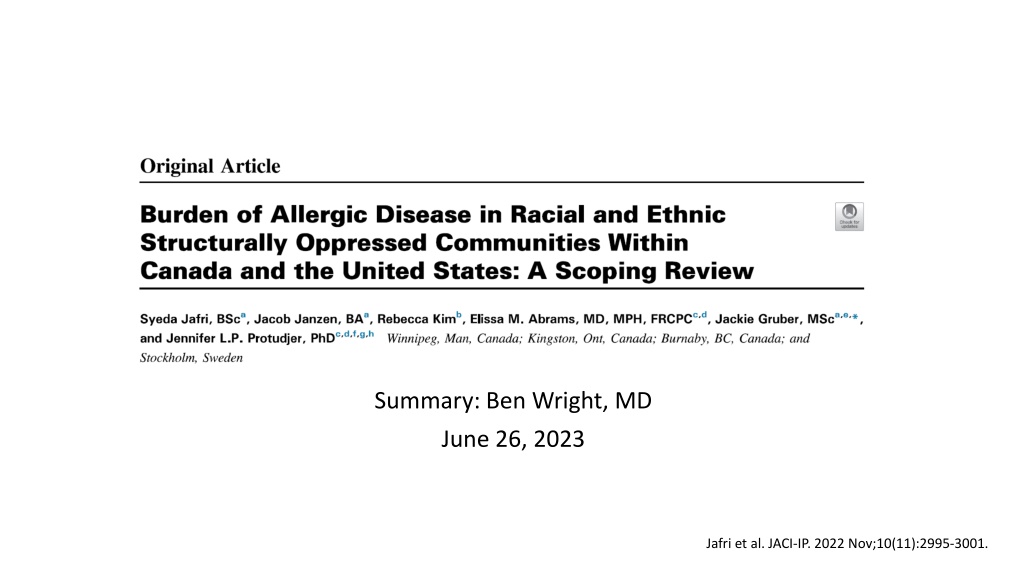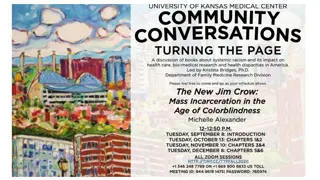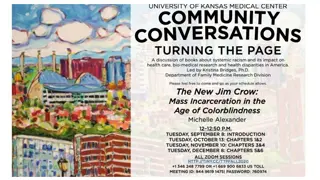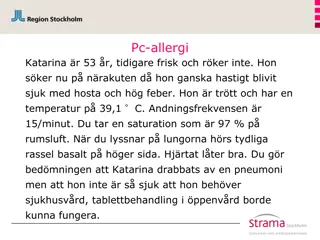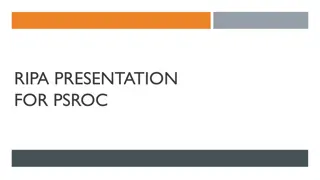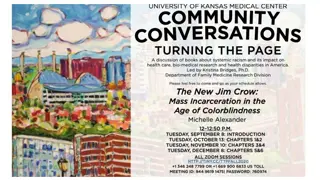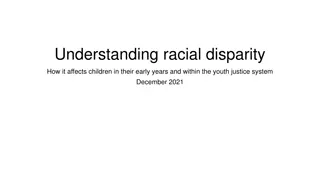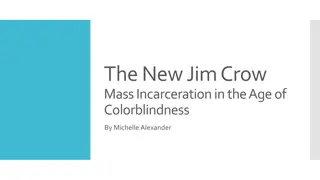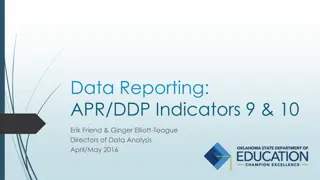Understanding Racial Disparities in Allergic Diseases: A Scoping Review
Social determinants of health impact chronic illnesses, with racial and ethnic groups facing barriers to care. This scoping review explores disease burdens in understudied populations, highlighting disparities in allergic diseases affecting marginalized groups like Black and Indigenous communities.
Download Presentation

Please find below an Image/Link to download the presentation.
The content on the website is provided AS IS for your information and personal use only. It may not be sold, licensed, or shared on other websites without obtaining consent from the author. Download presentation by click this link. If you encounter any issues during the download, it is possible that the publisher has removed the file from their server.
E N D
Presentation Transcript
Summary: Ben Wright, MD June 26, 2023 Jafri et al. JACI-IP. 2022 Nov;10(11):2995-3001.
Introduction Social determinants of health play a role in the development and progression of chronic illnesses. Social inequities present barriers to care. Historically oppressed racial and/or ethnic groups represent up to 20% of the population in Canada and/or the US. Allergic diseases have a prevalence of at least 10% and have been more studied in developed countries. Specific racial and ethnic groups are likely understudied. Scoping literature review conducted to describe the burden of disease specific to racial and ethnic populations.
Scoping Review vs. Systematic Review Researchers may conduct scoping reviews instead of systematic reviews where the purpose of the review is to: identify knowledge gaps scope a body of literature clarify concepts investigate research conduct Scoping reviews may also be helpful precursors to systematic reviews and can be used to confirm the relevance of inclusion criteria and potential questions. Munn et al. BMC Med Res Methodol. 2018; 18: 143.
Search Strategy 3 databases for relevant publications Scopus, Ovid, and CINAHL. First 10 pages of 4 relevant gray literature sites CPS, AAP, AAAAI, CSACI. Search strategy included keywords to identify: allergic diseases food allergies , allergic and atopic disease . target populations Indigenous, African American and/or Black, native American, and Hispanic and/or Latinx. English language. Contained information regarding burden of disease and access to care of allergic disease in populations of interest.
Results 12 articles published between 2006-2021 5 published on Black or African American individuals (1 retrospective chart review and 4 cohort studies published in US). 3 published in Indigenous Peoples of Canada 4 published on a combination of these and including Hispanic/Latinx peoples. No studies examined Hispanic, Latinx, or Native American populations or identity alone.
Studies published on Black or African American populations Asthma Hospitalization rates from 1980 to 2002: Black children - 34.3 to 36.5 discharges per 10,000 population (P < .03) White children - 11.5 to 8.1 discharged per 10,000 population (P <.01) Mortality Black children - 7.2 to 9.8 per 1,000,000 population (P < .002) -> 46 asthma-related deaths per yr. White children from 1.6 to 1.8 per 1,000,000 population. -> 12 asthma-related deaths per yr. Obesity Higher rates of obesity in Black adolescents with asthma compared to those without a history of asthma (OR 3.1, [1.2- 8.0], p=0.02) Food allergy Black children have higher rates of finned fish allergy (OR 2.54, p< 0.01) and shellfish allergy (OR 3.1, p < 0.01 compared to White children. EoE African American children more likely to have comorbid atopic dermatitis, greater diagnostic delay and earlier symptom presentation (9.1 vs. 3.7 years, p < 0.01)
Studies published on Indigenous Peoples of Canada Asthma Smoking, housing, air quality and lack of access to expert medical care identified as contributors to burden of disease. Higher prevalence of atopic dermatitis (25% Inuit children vs. 14.3% non-Inuit children, p = 0.016). Food allergy Prevalence of food allergy comparable to the general population.
Studies published on multiple racial/ethnic populations Asthma African American females had increased ED visits and inpatient admissions for asthma exacerbations. African American patients had higher daily ICS doses and increased overall cost of asthma care compared to White patients. Higher sensitization rates to indoor allergens vs. outdoor allergens: Hispanic (58.5% vs. 27%) African American (58.8% vs 31.6%) Asthma associated with sensitization to indoor allergens in African American and Hispanic children. Food allergy Black and Hispanic children had higher odds of allergy to wheat, soy, corn, and fish compared to White children. Compared to White children, higher rates of anaphylaxis were observed among African American children (OR 2.36, 95% CI 1.39-3.52) and Hispanic children (OR 2.80, 95% CI 1.70-4.64). EoE Compared with non-Black children, Black children were more likely to present with symptoms at a younger age, but be older at the time of an EoE diagnosis (P < .01).
Discussion Structurally and racially oppressed racial and ethnic communities face an increased burden of allergic disease. Increased mortality ED visits Hospitalizations Younger age at diagnosis or symptom onset Severity of disease Sensitization to addition food allergens. Asthma severity Studies of allergy in Native American, Indigenous People of Canada, and Hispanic populations are lacking.
